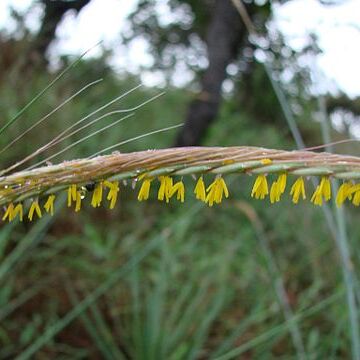Spikelets in pairs at the nodes of a slender continuous rachis, one nearly sessile, staminate awnless, the other pedicellate, perfect, long-awned; pedicel of the per-fect spikelet obliquely disarticulating near the base, forming a sharp bearded callus below the spikelet; first glume of perfect spikelet firm, rounded on the back, several-nerved, obtuse; second glume firm, obscurely nerved; fertile lemma narrow, extending into a stout, twisted, geniculate or flexuous, often plumose awn; sessile spikelet as large as the fertile spikelet, persistent, awnless.
Inflorescence of single or digitate racemes, racemes tough, with linear internodes, bearing paired spikelets, one subsessile, one pedicelled.
Subsessile spikelet male or barren, awnless (sometimes fertile and awned in T. chevalieri), persistent on the rhachis.
Pedicelled spikelet bisexual, subterete, the callus pungent and obliquely attached to the internode.
Superior lemma linear, entire, with a pubescent or plumose awn.
Inferior glume coriaceous, convex, obtuse at the apex.
Inferior floret reduced to a hyaline lemma.

